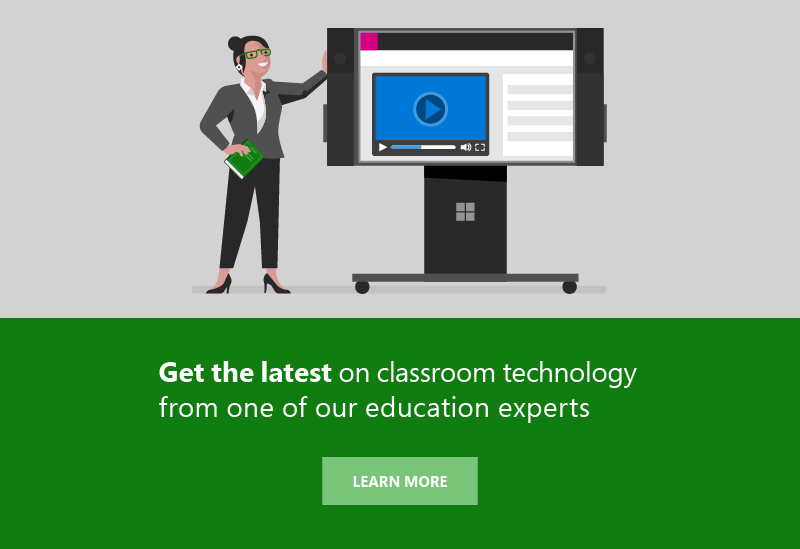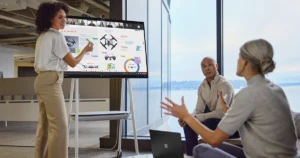
How Kennedy Middle School boosts classroom mobility with Surface Pro
As Mike Spurr, the band director at Kennedy Middle School, makes his way through rows of students carefully learning the craft of their instruments, he stops by each member of his orchestra of middle schoolers to give them the attention and guidance they need. With the power of lightweight, digital technology, Spurr is able to navigate around his students to easily record them and provide them with detailed instruction, resulting in a tactical learning experience that drives educational development and optimizes student engagement.

This is the kind of hands-on learning Kennedy Middle School has begun developing for its student body of over 600 seventh and eighth graders. The high-performing Florida middle school has recently undergone a digital transformation with the goal of integrating innovative technology into the classroom to create a more engaging and experiential learning environment. As more students and faculty become equipped with the new systems and technology, the educational outcomes and productivity improvements have been quite substantial.
Updating systems to drive educational development
Prior to Kennedy Middle School’s digital transformation, students and teachers relied on seven computer labs with over 400 desktop computers. These bulky devices offered limited mobility for teachers, hindering advanced learning outcomes for students. As part of a long-term plan to modernize the school, Warren McCarthy, the school’s technology associate, began looking for cost-effective solutions to bring wireless capabilities into the classroom.
McCarthy has managed KMS’s technology infrastructure for over eight years. While they had recently added 366 laptops for students to use, he realized they were limited by the current technology and began looking to upgrade the school with wireless capabilities.
While the school’s building was already equipped to support wireless connectivity, it didn’t have the sufficient infrastructure in place to support a full range of digital devices. With limited funds, McCarthy set out to find a cost-effective solution that would give students and teachers alike the power of mobility with updated tools and opportunities.
Launching a program for success
To start their digital transformation, KMS began rolling out a Surface Pro pilot program. With the goal of completely transforming the educational experience, the school implemented a multi-year strategy to support a seamless migration. The goal was to eventually replace teacher workstations with Surface Pros. The long-range plan also included infrastructure changes and network improvements coupled with support for educators, so they could troubleshoot the setup of their new devices.
The first to leverage this new technology in their classrooms were the school’s math teachers. With Surface Pros in hand, educators could transform traditional lecture style teaching formats and develop a collaborative learning experience. One teacher arranged her students’ desks into clusters and now uses Surface Pro to easily navigate around the classroom to engage students directly, giving them the opportunity to answer equations on the screens. The transformative nature of this new technology has led to strong improvements in student engagement while also reducing disciplinary issues.
After seeing the benefits in math classrooms, the school’s digital transformation team was able to better imagine how they might implement this technology into non-STEAM courses. The success of Surface Pro in these classrooms helped KMS build a blueprint for how they could integrate the devices into every classroom.
“With Surface’s portability and the wireless feature, that changes how you think of teaching and how your lessons look and what your kids will experience in the classroom. We can always innovate how we’re teaching,” says Spurr.
Delivering dynamic experiences for students
The newly integrated classroom technology provides students the tools they need to be successful and adequately engaged in all learning opportunities. In a survey last year, more than 80% of Kennedy Middle School students indicated that an increase in technology positively impacts their learning. With teachers who are pushing the pilot program forward, the momentum has begun to pick up. Students are more actively participating in the classroom for the entire duration of lessons, and teachers have a fully functional device to deliver a dynamic approach to the education experience.

After seeing great success with Surface Pro devices, teachers wanted to expand the mobile experience of their new equipment to every corner of the classroom. They have now deployed ScreenBeam wireless display to provide a Miracast connection between Surface Pro devices and classroom displays.
“Because of the mobility of the Surface Pros and flexibility of the wireless displays with the ScreenBeams, educators can basically shape their classrooms however they want,” explains McCarthy. “It significantly changes how they interact with the students and the classroom.”
A vision for the future
Moving forward, the faculty at KMS want to achieve a more robust approach to integrating technology into the classroom. They want to ensure they are thinking about how they can leverage these new innovative platforms from the beginning of each school year and follow through with a plan, so each student can maximize their exposure to advanced learning capabilities.
“We’ve built in some common planning and time specifically for collaboration earlier in the school year and throughout the school year to make it a whole lot easier for teachers to collaborate and work together to use the technology in the classroom,” says Tami Davis, Assistant Principal at Kennedy Middle School.
KMS has experienced a positive academic outcome of integrating these technologies into the classroom experience. This has fostered a greater sense of development across the board for teachers and students alike. With the system in place to continue building a dynamic classroom environment, they expect future technology transitions to be much more seamless with less disruption.
It can be difficult for educators to inspire a new generation of digitally minded students. From developing curriculum that takes into consideration how technology has changed the way students understand the world, to targeting learning in a way that drives the most engagement, there are always new challenges. However, the faculty and staff at Kennedy Middle School are conquering these obstacles by using innovative technology to engage students at new levels. By embracing digital transformation, teachers are now opening their classrooms to endless learning possibilities.





